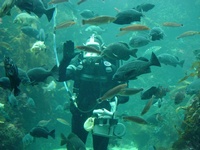
Surface supplied diving refers to divers using equipment supplied with breathing gas using an umbilical cord from the surface, often from a diving support vessel but possibly, indirectly via a diving chamber. SCUBA, which is commonly used in recreational diving, is the main alternative to surface supplied diving equipment. Surface supplied diving equipment and techniques are mainly used in professional diving or military diving due to the increased cost and complexity of buying and operating the equipment. This type of equipment is used in saturation diving. Divers almost always wear diving helmets or full face diving masks when being supplied from the surface. Surface supplied divers also use the spherical helmet with brass and glass windows of the historical standard diving dress. A very simple system called a Hookah allows recreational divers to enjoy surface supplied diving. The system consists of: A filter, a compressor run most often by a small gasoline engine, reserve tank and a hose to reach the diver and a regulator for the diver. Surface supplied diving equipment usually includes communication capability with the surface, which adds to the efficiency of the working diver. The surface supplied diver is less likely to have "out-of-air" emergencies because when a cylinder supplying the umbilical is exhausted it can be removed and replaced with a full one at the surface.